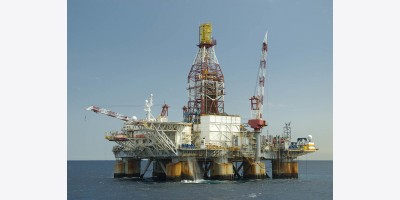Houston (Platts)
US crude oil production from shales is projected to fall for the fourth month in a row in August to 5.357 million b/d, a drop of 91,000 b/d from July estimates, the US Energy Information Administration said Monday in its latest Drilling Productivity Report.
It is the second consecutive month the agency has predicted a month-on-month decline of 91,000 b/d.
The data, which EIA began publishing in October 2013, showed estimated oil production in the Bakken, Eagle Ford and Niobrara shale plays dropping in August, although Permian Basin production will continue to rise.
EIA data predicted oil output in the Permian, located in West Texas and New Mexico and widely considered the US' hottest unconventional play, to increase 5,000 b/d in August to 2.046 million b/d. That is up from the 3,000 b/d increase that the agency estimated for July.
The Permian benefits from a large number of "stacked" or pancaked pay intervals that industry has found to be productive.
The Eagle Ford, sited in South Texas, should continue to show the steepest decline in August among US shale plays, the EIA said, a continuing trend since the projected declines began to show up in May. Next month, the agency predicts crude output there will drop 55,000 b/d to 1.538 million b/d, more than the 49,000 b/d decrease estimated for July.
In addition, oil production from the Bakken Shale in North Dakota and Montana should drop 22,000 b/d to 1.182 million b/d in August, slightly less than the 29,000 b/d decline predicted for July. Also, oil output in the Niobrara Shale in Colorado and Wyoming should fall 20,000 b/d to 395,000 b/d, a bit higher than the 17,000 b/d decline forecast for July, the EIA said.
Meanwhile, new-well oil production per rig in each of those plays will continue to rise in August, according to EIA forecasts. In the Permian, the average amount of oil produced by new wells should increase to 327 b/d, compared with 315 b/d predicted last month. In the Bakken, the figures were 691 b/d in August, compared with 654 b/d in July; in the Eagle Ford, 766 b/d, compared with 741 b/d; and in the Niobrara, 516 b/d, compared with 510 b/d.
Oil companies have noted that efficiencies, internal cost-cutting, and price concessions in oilfield equipment and services allowed them to do more with fewer rigs.
Besides the Bakken, Eagle Ford, Permian and Niobrara, the EIA also makes predictions about production and new-well production per rig for the Haynesville Shale, located in Texas and Louisiana; the Marcellus Shale, which is mostly found in Pennsylvania; and the Utica Shale, chiefly sited in Ohio. However, these three shale plays are mostly gas-prone, and oil production is very low or negligible.
In total, the seven US shale plays accounted for 95% of US crude oil production growth and all domestic gas output growth during 2011-2013.
The EIA's projections for the crude oil output drop in the seven largest US shale plays come amid domestic oil prices that have dropped about 13% this month to the low $50s/barrel after largely hovering around $60/b for most of May and June. Oil is now less than half of mid-2014 highs of about $107/b.
On Monday, WTI was down 54 cents to $52.20/b, while ICE August Brent settled down 88 cents at $57.85/b.
While the EIA report showed production data only and does not offer interpretation, it is likely that the continued drop in the domestic oil rig count from an October 2014 high of 1,609 to 645 on Friday is responsible for the EIA's persistent forecast of production declines.
In its forecasting, the EIA uses recent data on the total number of drilling rigs in operation, along with estimates of drilling productivity and projected changes in output from existing oil and natural gas wells.
--Starr Spencer, starr.spencer@platts.com
--Edited by Annie Siebert, ann.siebert@platts.com
platts.com























